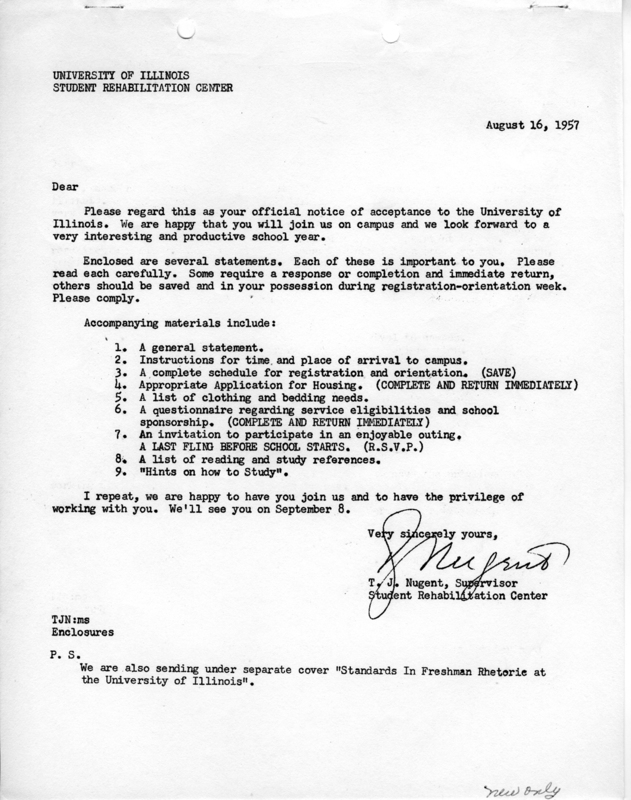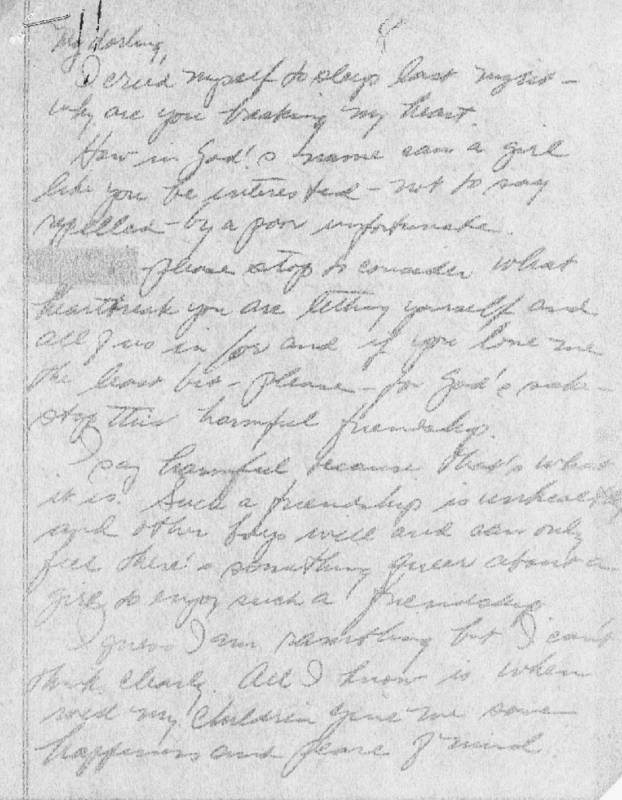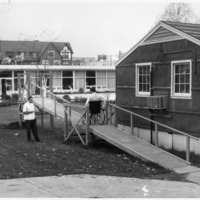Part One: Overcoming Barriers
Galesburg Experiment
In the 1947-1948 academic year, a former Veterans Administration Hospital in Galesburg, Illinois became a satellite campus of the University of Illinois. This campus was established to accommodate the influx of World War II veterans who were taking advantage of the GI Bill to earn their college degrees. Although Galesburg did not exclusively serve veterans and non-veterans with disabilities, its facilities made it particularly well-suited for such students. Dean Chauncey Louttit of the Galesburg Division selected Timothy Nugent, a 24-year-old University of Wisconsin doctoral candidate, to head the corrective physical education and therapy program. By the fall of 1948, 13 students with disabilities were enrolled full time.
In a letter from June 3, 1949, Robert G. Bone, Director of Division of General Studies, discussed the possibility of transferring the program from Galesburg to Champaign-Urbana. Bone noted that Nugent "has done a remarkable job. He is a delightful, energetic person whose enthusiasm is contagious. . . . It would seem wise to make use of the equipment at Galesburg as well as the services of Mr. Nugent."
In addition to academic pursuits, students in the program participated in bowling, swimming, and basketball. The first National Wheelchair Basketball Tournament (NWBT) was held in April 1949, which led to the founding of the National Wheelchair Basketball Association (NWBA). The original teams were the U of I Gizz Kids, the Kansas City Bulldozers, the Hannibal (MO) Rockets, the Minneapolis Rolling Gophers, the Evansville (IN) Rolling Rockets, and the Chicago Cats. The Gizz Kids placed third.
The youngest member of the Gizz Kids Wheelchair Basketball team of the Galesburg Division of the University of Illinois, Waller captained the 1949 team to victory over the Paris High School All-Stars, 48-19. The game was played for the benefit of the Edgar County Polio Fund.
In early 1949, Governor Stevenson announced that the Galesburg Campus would be closed. Nugent and 30 students staged a march on the state capital in Springfield to try and dissuade Governor Stevenson. He avoided meeting with them but their efforts generated statewide media attention. In search of a new school to continue their education, many students visited Champaign-Urbana to demonstrate to administrators that that they could successfully negotiate the campus with minimal assistance. On May 4, 1949, the University of Illinois initiated plans to provisionally accept 14 of the students with disabilities from Galesburg for the fall semester in Champaign-Urbana. However, no other students would be allowed to enter, and no funding was established for the program.
The Rehabilitation Program was housed in a tar paper U.S. Army surplus barracks with a space heater and no insulation.
The Orientation Packet for New Students August 16, 1957, indicates the level of organization expected from participants in the DRES program.
Public Attitudes toward People with Disabilities
Tim Nugent believed education was crucial to help people with disabilities help themselves and become productive members of society. The biggest barrier to overcome was often not physical but rather negative public attitudes toward people with disabilities.
A mother writing to her daughter:
"How in God's name can a girl like you be interested-not to say repelled-by a poor unfortunate . . . . please stop to consider what heartbreak you are letting yourself and all of us in for . . . stop this harmful friendship."
A man writing to a student with a disability:
"[The rehab] gives you an opportunity to go to school and relieve taxpayers of liability for your care . . . but it is costing taxpayers money to give you this and we should be protected against your dating or socializing with our sons and daughters."
Notes gathered to illustrate public attitudes toward people with disabilities which mention the attitude of a man writing to a student with a disability.
A Different Perspective
DRES students' own letters to staff member Joseph Konitzki indicate a different story, one of academic and extra-curricular success.
Byron E. Carter, February 14, 1964:
"I am now looking forward to a productive life which I could not have had had it not been for my experiences at U. of Illinois. It is impossible to express my gratitude to both you and Mr. Nugent (at one time I thought him to be meanest man alive). . . . P.S. I am driving now, which is another thing I am proud of, dating girls and having a great and very normal life. It is tremendous."
Allen F. Wall, comparing the U of I's program with that of the University of Missouri, December 9, 1967:
"Their approach to handicapped students on campus is quite different than yours. I was told that I must have an attendant and that I must have an electric wheelchair to get by there. No one seemed interested in finding out if I could do more for myself than I have been. This seems to me to be the wrong direction for me to go. . . ."
In a response to a letter to the editor in The Daily Illini, 1956, in which the writer described how he was shocked by the "callous" attitude and "apathy" of University students toward students in wheelchairs, DRES students Phyllis Voy and Lola K. Lange explain why they refused "a push."
"First, all of us in wheelchairs follow a physical education and rehabilitation program as important as our educational program. It is designed to make us completely self-sufficient. By accepting help, we would defeat our purpose. Second, the main goal of every person who is "different," whether his difference shows or not, is to have this difference overlooked and to be accepted for himself. The students who passed us as we were all leaving the stadium were not ignoring us. They are used to us. To them, we were just other students streaming jubilantly away from a very exciting football game."



















